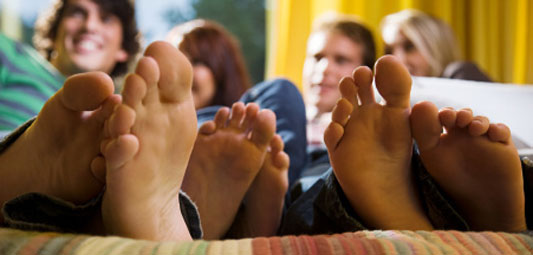A lot of adults suffer from foot pain and discomfort for a variety of reasons, but did you know that six out of 10 teens have foot pain, too? A survey conducted by the American Podiatric Medical Association (APMA) shows that
- sports are the number one cause of foot pain among teens;
- two out of 10 teens suffer from pain due to wearing high heels and other uncomfortable footwear; and
- less than two out of 10 teens have ever seen a podiatrist to treat foot problems.
Foot health is incredibly important to a person’s overall health and wellbeing — especially in the teen years when feet are still growing. Our survey found that only about half of teens see feet as important to their overall health, but many are living with foot pain. It’s vital that we educate teens on how to properly care for their feet and when to visit today’s podiatrist, the foot and ankle expert.
APMA’s survey collected the opinions of 1,000 teenagers on their attitudes toward foot health, foot care, and their knowledge of and experience with podiatrists. Among the key findings:
- Almost half reported that playing a sport was the cause of their foot pain. Seventy-five percent of high school students play a school or recreational sport, and nearly 40 percent of that group has injured their feet while participating in sports.
- Not surprisingly, gender differences were also found to play a role in how teens care for their feet. Two out of every 10 teens suffer from pain from uncomfortable shoes — girls more than boys. It’s all about the type of shoes — high heels are the most painful, reported by 64 percent of girls who took the survey.
Helpful advice from the APMA includes:
How to Choose Good Shoes
- Activity: Sports-specific shoes help protect against injury.
- Size: Teen feet are still changing and shoe sizes can vary from one brand to another.
- Support: Make sure your shoes support your feet when you walk. Well-made backless shoes and flip-flops are fine, but shouldn’t be worn all the time, and high heels should be reserved for special occasions. Stilettos can be a problem due to lack of stability.
- Maintenance: Check the cushioning, tread, and midsole, and replace shoes that are showing signs of wear and tear.
Basic Foot Care
- Give ‘em a good washing: You’d think this would go without saying, but it is tempting to just swish your feet around in the shower. Podiatrists say it’s important to use soap to remove germs and grime, and it’s important to get in between your toes.
- And a thorough drying: Fungus, like the kind that causes athlete’s foot, grows in moist, damp environments. After your shower, dry your feet thoroughly, especially in between your toes. If your socks get wet during the day, change socks. (Keep an extra pair in your locker or gym bag.)
- Give toenails a little TLC: Toenails that are too long can harbor bacteria. Use a pair of toenail clippers to cut your toenails to just above or at the edge of your toe. Some docs will tell you to cut straight across the nail, but a slight curve is OK too.
Common Foot Problems…and what to do about them
- Warts: Common warts, which can appear anywhere on the body, are rough little bumps. Plantar warts, which occur on the bottom of the feet, are typically hard, flat, and rough. All warts are caused by a virus. Warts aren’t harmful, but they can be uncomfortable and unsightly. If you have warts on your feet, keep your feet clean and dry because viruses flourish in dark, wet environments.
- Sweaty, smelly feet: You can cut down on odors by keeping your feet clean and dry at all times. Rubbing powder on the bottom of your feet before putting on your socks and shoes can help too. If possible, let shoes air out for 24 hours before wearing them again. Podiatrists can help with this embarrassing problem.
- Ingrown toenails: Symptoms of an ingrown toenail include redness, swelling, and tenderness around the nail. Sometimes you can even see the nail digging directly into the toe. Try soaking the affected foot in lukewarm water and Epsom salts for 20 minutes three or four times a day. If the redness and pain don’t improve after a couple days, a podiatrist can easily treat ingrown toenails.
- Athlete’s foot: Athlete’s foot, an itchy foot condition that causes the skin to flake and peel, is caused by a fungus. Keeping your feet clean and dry can help. So can over-the-counter athlete’s foot medication. Just be sure to use the medication until the fungus is completely gone. With current medications, two to three weeks of treatment may be enough to treat athlete’s foot fungus. Stubborn cases of athlete’s foot may require a doctor’s care.
If you have been experiencing Foot Pain, contact the Foot and Ankle Specialists at Achilles Podiatry for further evaluation and treatment.
Source: Care2

